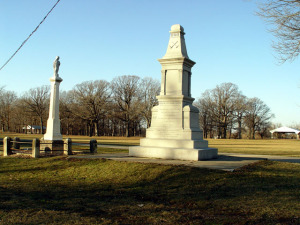INDIAN CREEK
|
INDIAN CREEK |
|
|
|
|
NAME: Indian Creek COUNTY: LaSalle ROADS: 2WD GRID: 2 CLIMATE: cool winter, hot summer BEST TIME TO VISIT: anytime |
COMMENTS:
The site is within LaSalle County's Shabbona Park. Located north of Ottawa and approximately 1 mile west of IL 23 on N 42nd Rd. The settlement was the site of the Indian Creek Massacre. A monument to the massacre marks the site. REMAINS: Monument to the massacre |
| This settlement became famous because of the Indian Creek Massacre which occurred on May 21, 1832. The massacre was one of the events that were used to justify the Black Hawk War. While at the time it was thought to have been sanctioned by Sauk Chief Black Hawk, today historians generally agree that Black Hawk had no involvement at all in the incident. Instead it was most likely started by a settler named William Davis and his refusal to remove a dam. Davis was a blacksmith and a mill operator and had dammed Indian Creek, violating Native American water rights and threatening a vital source of food to a nearby Potawatomi village. Specifically, Davis had raised the ire of Keewasee, a young Potawatomi who lived in the village. Keewasee requested Davis remove the dam but his pleas went unheeded and were contemptuously denied. Keewasee had tried to tear down the Davis dam but was caught while doing so and beaten by Davis with a hickory stick. At the same time, the Black Hawk War had erupted in Illinois and the first battle at Stillman's Run proved to be a victory for Black Hawk's band. This event may have also encouraged the assault at Indian Creek. Though warned by Potawatomi Chief Shabbona of possible hostilities, Davis chose to stay and persuaded a few families to stay as well. In all 22 people were present on the day of the attack. On the afternoon of May 21, 1832, between 20 and 40 Potawatomi and three Sauk, led by the notorious outlaw Mike Girty attacked the Indian Creek settlement. Girty was a white man who had allied himself with local Indians and was known as the White Savage. The attack was so swift; the settlers had practically no time to organize any resistance though it is thought that Davis was able to kill one warrior before he himself was killed. The attack lasted approximately 10 minutes. During the attack 15 people (including women and children) were killed and 2 young women were taken prisoner. The remaining 4 survivors, one of whom was wounded, escaped to Ottawa where they reported the massacre. The news lead to mass hysteria amoung the local white population. The two captured women were held for 11 days and then ransomed for some horses and food. The Indian Creek massacre soon became one of the most famous and well publicized incidents during the Black Hawk War. At the Battle of Bad Axe in Wisconsin, the massacre was used as a battle cry which ironically also turned into a massacre of Black Hawk's followers who were mostly women and children. Submitted by: Brian Tjernlund |  Monument at Indian Creek Massacre site. Courtesy Brian Tjernlund |
|
|